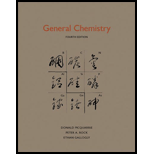
Concept explainers
a)
Interpretation:
Balanced chemical equation for reaction of iron with sulfuric acid has to be determined.
Concept Introduction:
The reaction that has equal number of atoms of different elements in reactant as well as in product side is called balanced
b)
Interpretation:
Mass of
Concept Introduction:
Mole is S.I. unit. The number of moles is calculated as ratio of mass of compound to molar mass of compound.
Molar mass is sum of the total mass in grams of all atoms that make up mole of particular molecule that is mass of 1 mole of compound. The S.I unit is
The expression to relate number of moles, mass and molar mass of compound is as follows:
For more than one quantity of reactants in a reaction, the reactant that is completely consumed and controls the amount of product synthesized is called limiting reactant. The other reactants are called excess reactants. Also, the limiting reactant is completely consumed the initial mass of limiting reactant is used to calculate mass of product.
Percent yield is ratio of actual yield by theoretical yield. Actual yield is amount of actual product formed in chemical reaction.
Theoretical yield is amount of product formed from reactant according to stoichiometry in the balanced chemical reaction.
The expression for percent yield is as follows:
Want to see the full answer?
Check out a sample textbook solution
Chapter 11 Solutions
General Chemistry
 ChemistryChemistryISBN:9781305957404Author:Steven S. Zumdahl, Susan A. Zumdahl, Donald J. DeCostePublisher:Cengage Learning
ChemistryChemistryISBN:9781305957404Author:Steven S. Zumdahl, Susan A. Zumdahl, Donald J. DeCostePublisher:Cengage Learning ChemistryChemistryISBN:9781259911156Author:Raymond Chang Dr., Jason Overby ProfessorPublisher:McGraw-Hill Education
ChemistryChemistryISBN:9781259911156Author:Raymond Chang Dr., Jason Overby ProfessorPublisher:McGraw-Hill Education Principles of Instrumental AnalysisChemistryISBN:9781305577213Author:Douglas A. Skoog, F. James Holler, Stanley R. CrouchPublisher:Cengage Learning
Principles of Instrumental AnalysisChemistryISBN:9781305577213Author:Douglas A. Skoog, F. James Holler, Stanley R. CrouchPublisher:Cengage Learning Organic ChemistryChemistryISBN:9780078021558Author:Janice Gorzynski Smith Dr.Publisher:McGraw-Hill Education
Organic ChemistryChemistryISBN:9780078021558Author:Janice Gorzynski Smith Dr.Publisher:McGraw-Hill Education Chemistry: Principles and ReactionsChemistryISBN:9781305079373Author:William L. Masterton, Cecile N. HurleyPublisher:Cengage Learning
Chemistry: Principles and ReactionsChemistryISBN:9781305079373Author:William L. Masterton, Cecile N. HurleyPublisher:Cengage Learning Elementary Principles of Chemical Processes, Bind...ChemistryISBN:9781118431221Author:Richard M. Felder, Ronald W. Rousseau, Lisa G. BullardPublisher:WILEY
Elementary Principles of Chemical Processes, Bind...ChemistryISBN:9781118431221Author:Richard M. Felder, Ronald W. Rousseau, Lisa G. BullardPublisher:WILEY





